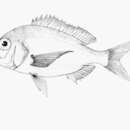Diagnostic Description
provided by FAO species catalogs
Body oval, rather deep and compressed. Head profile straight; interorbital space narrow (21 to 25% of Head length); suborbital space wide (17 to 21% of head length). Scales present on cheeks and anterior part of preopercle. Mouth low, slightly oblique. Several rows of canine-like teeth, outer row the strongest with 4 to 6 better developed anterior teeth in each jaw, the uppers visible when mouth is closed. Gillrakers on first arch 9 or 10 lower and 6 to 9 upper. Dorsal fin with 12 spines increasing in length up to the fourth or fifth and subequal thereafter, and 9 or 10 soft rays; anal fin with 3 spines and 7 or 8 soft rays. Scales along lateral line 45 to 49. Colour red with silvery reflections, head darker and belly lighter; a small dark area above the insertions of pectoral fins; dorsal and anal fins red except on their bases; pelvic fins light-coloured; pectoral fins and caudal fin reddish.
- Cadenat, J - 1953. Notes d'ichthyologie ouest-africaine. VI. Poissons des campagnes du "Gérard Treca". Bull. Inst. Fr. Afr. Noire, Dakar, 15 (3): 1051-1102, fig. 1-43.
- Klunzinger, C - 1870. Synopsis der Fische des Rothen Meeres. I. Theil. Percoiden-Mugiloiden. Verh. K.-K. Zool.-Bot. Ges. Wien v. 20: 669-834. [Also as "Systematische Uebersicht der Fische des Rothen Meeres, als Anhang und Register zur Synopsis." Wien, 1871.]
- Norman, J.R - 1935. Coast fishes. Part I. The South Atlantic. "Discovery" Rep., 12: 1-58, 15 fig.
- Poll, M. and G.E. Maul - 1953. Description de Dentex angolensis, espèce nouvelle d';une grande importance économique, de la côte occidentale d'Afrique tropicale. Bull. Inst. R. Sci. Nat. Belg. v. 29 (no. 49): 1-7.
- Rico,V., J.I. Santana & J.A. González - 1995. Ocurrence of Dentex (Polysteganus) angolensis Poll and Maul, 1953 (Sparidae) in the Canary Islands. Cybium, 1995, 19 (4): 323-432.
- Roux, C - 1954. Description de deux espèces nouvelles de poissons des côtes d'Afrique Équatoriale Française, Dentex polli et Scorpaena gaillardae. Bull. Mus. Natl. Hist. Nat. (Sér. 2) v. 26 (no. 4): 468-472.
Size
provided by FAO species catalogs
Maximum 37 cm; common to 24 cm
Brief Summary
provided by FAO species catalogs
Benthopelagic and demersal behaviour.Occurs on varied seabeds-mainly sandy mud substrates on the shelf and upper slope from 15 to 700 m, older individuals found in even greater depths. A protogynic hermaphrodite (the majority of individuals are first females and become males at 18 - 23 cm length). In the Gulf of Guinea, there are two spawning seasons, the most important extending from May to July. Carnivorous (mainly crustaceans, also fish, sometimes molluscs and worms).
Benefits
provided by FAO species catalogs
From Agadir (Morocco) to Angola; a seasonal fishery linked to upwellings (maximum landings from June to October). Separate statistics for this species are reported by Ghana only (about 4300 t in 1977). Caught with bottom trawls and bottom longlines. Flesh highly esteemed. Marketed fresh or frozen, sometimes dried salted. Also used for fishmeal and oil.
Trophic Strategy
provided by Fishbase
Occurs in various types of bottoms on the continental shelf and slope from 15 to 300 m depth; old fish occurring in the deeper waters. Feeds mainly on crustaceans; also on fish, sometimes on molluscs and worms.
- Recorder
- Drina Sta. Iglesia
Biology
provided by Fishbase
Occurs in various types of bottoms on the continental shelf and slope; old fish occurring in the deeper waters. Feeds mainly on crustaceans; also on fish, sometimes on mollusks and worms.
Importance
provided by Fishbase
fisheries: commercial

